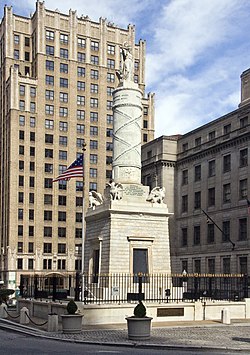Battle Monument Square
|
Battle Monument
|
|

Battle Monument, Baltimore, October 2011
|
|
| Location | Calvert St. between Fayette and Lexington Sts., Baltimore, Maryland |
|---|---|
| Coordinates | 39°17′26″N 76°36′45″W / 39.29056°N 76.61250°WCoordinates: 39°17′26″N 76°36′45″W / 39.29056°N 76.61250°W |
| Area | 1 acre (0.40 ha) |
| Built | 1815 |
| Architect | Godefroy, J. Maximillian M.; Capellano, Antonio (crowning statue sculpture) |
| NRHP reference # | 73002181 |
| Added to NRHP | June 4, 1973 |
The Battle Monument, located in Battle Monument Square on North Calvert Street between East Fayette and East Lexington Streets in Baltimore, Maryland, commemorates the Battle of Baltimore with the British fleet of the Royal Navy's bombardment of Fort McHenry, the Battle of North Point, southeast of the city in Baltimore County on the Patapsco Neck peninsula, and the stand-off on the eastern siege fortifications along Loudenschlager and Potter's Hills, later called Hampstead Hill, in what is now Patterson Park since 1827, east of town. It honors those who died during the month of September 1814 during the War of 1812. The monument lies in the middle of the street and is between the two Baltimore City Circuit Courthouses that are located on the opposite sides of North Calvert Street. It was sponsored by the City and the "Committee of Vigilance and Safety" led by Mayor Edward Johnson and military commanders: Brig. Gen. John Stricker, Maj. Gen. Samuel Smith and Lt. Col. George Armistead (of Ft. McHenry).
The site of the former first Baltimore County and Town/City Courthouse (torn down in 1809) was originally designated as the location for the newly planned Washington Monument. Designed by Robert Mills (1781-1855), the cornerstone of the Washington Monument for Baltimore had just been laid on Independence Day, July 4th, 1815. But fears that the designed shaft of the column would be too tall for the smaller open space of the old Courthouse Square, and might fall over onto nearby close-in townhouses, caused a last-minute change in location. The monument site for the nation's first president was moved further north of the city into "Howard's Woods" of the "Belvindere" estate of Col. John Eager Howard (1752-1827).
...
Wikipedia



